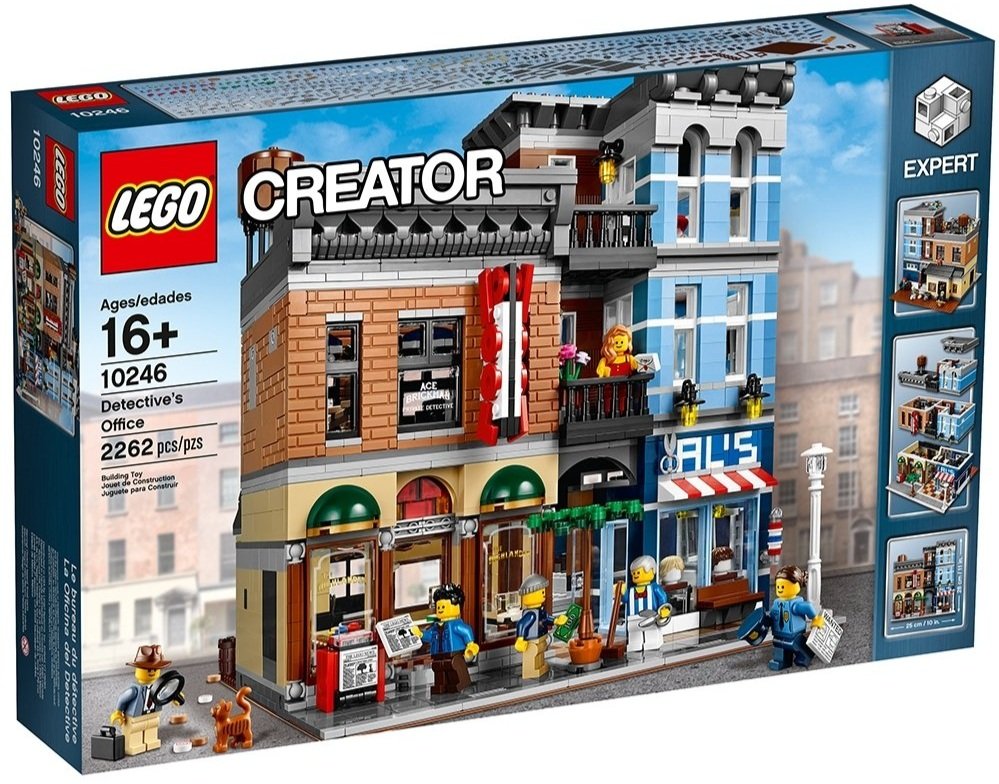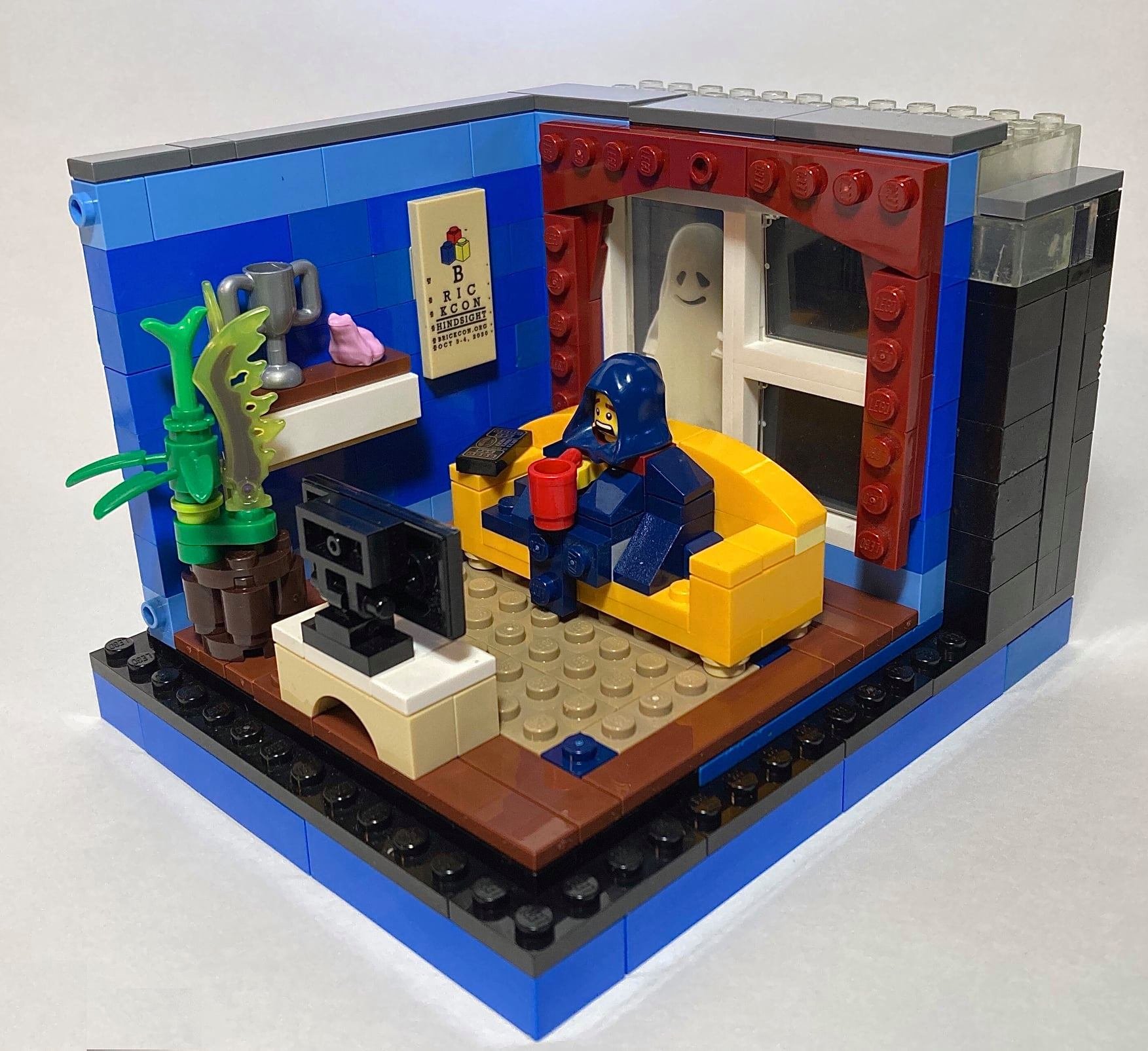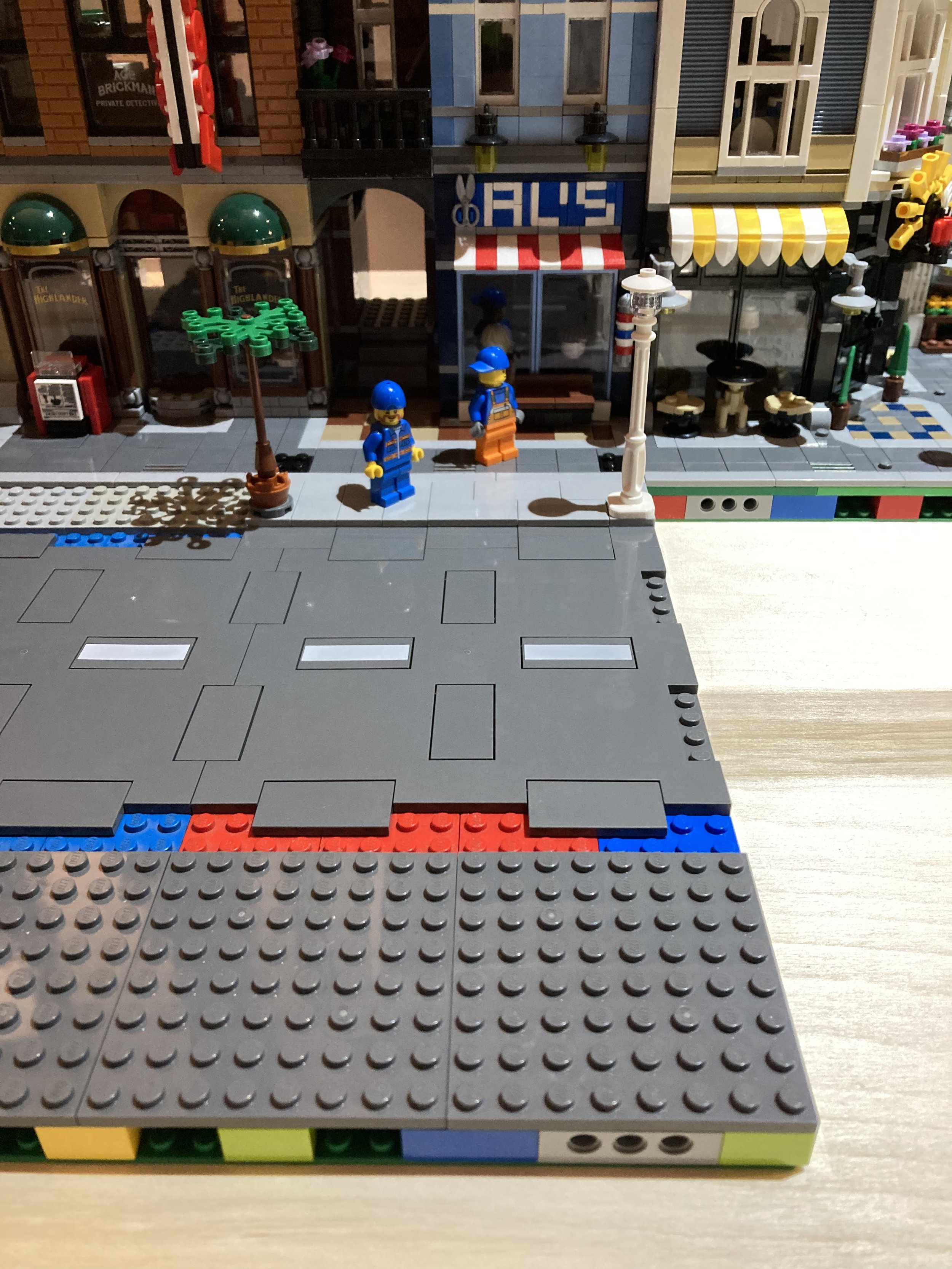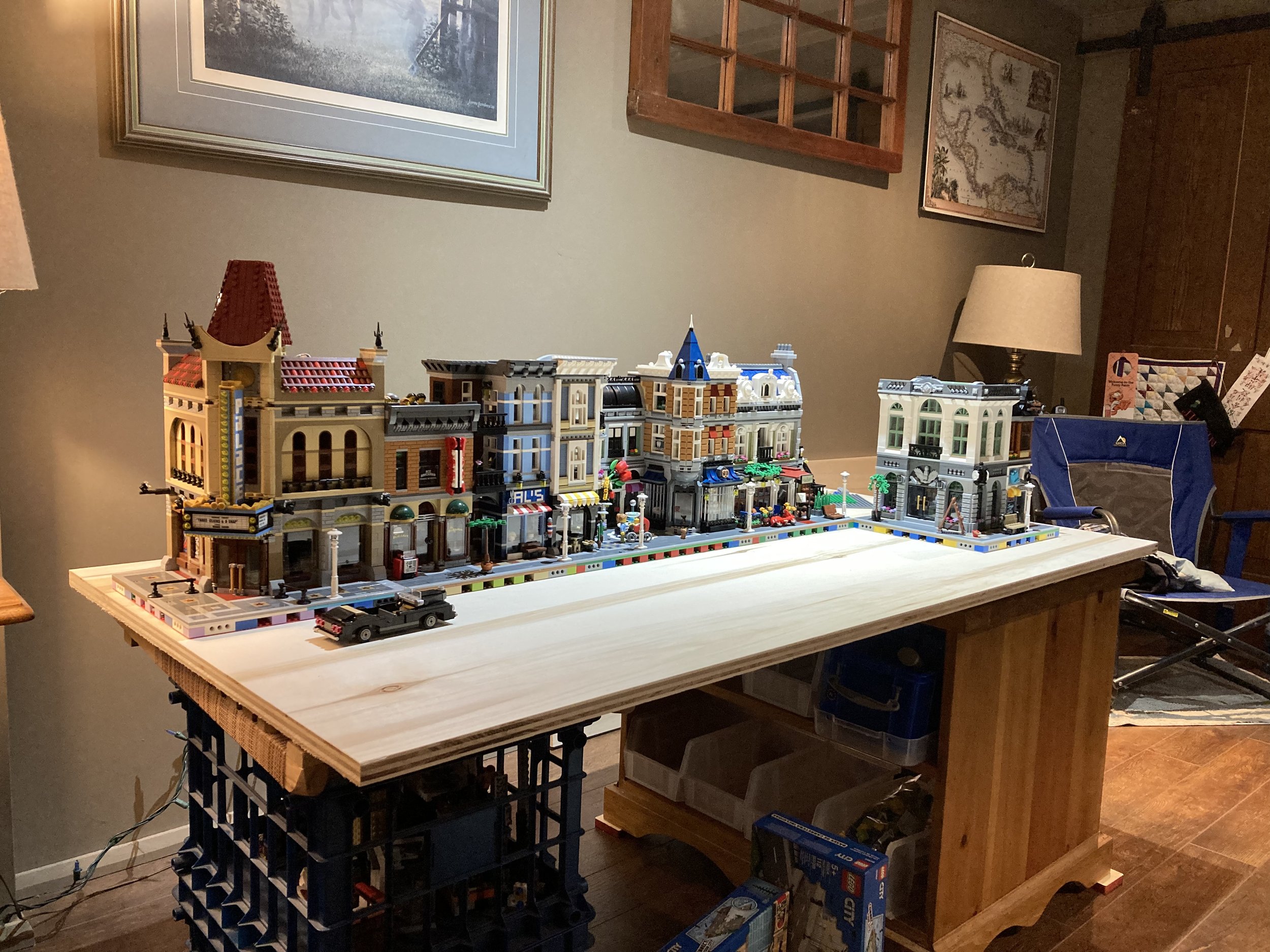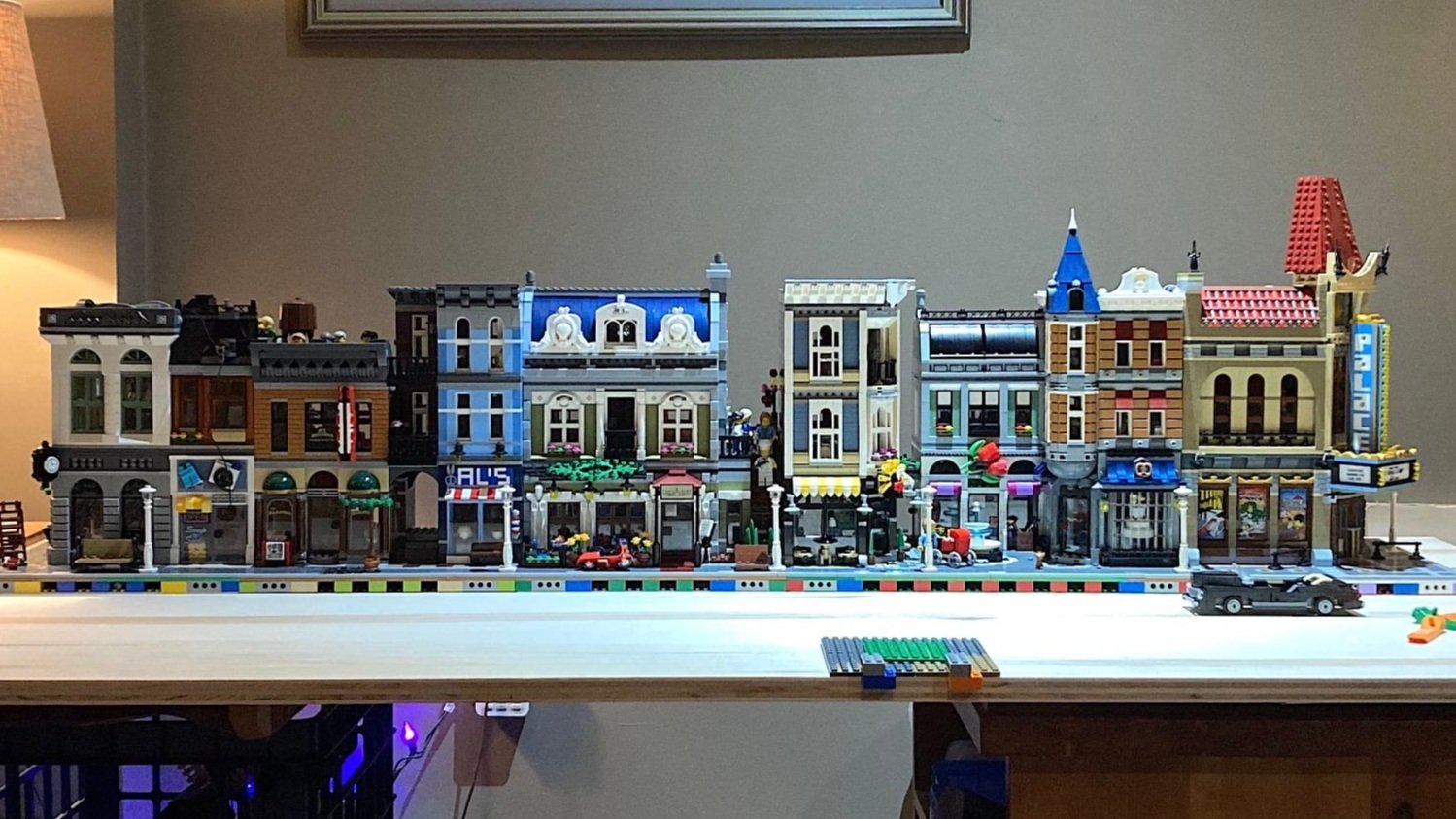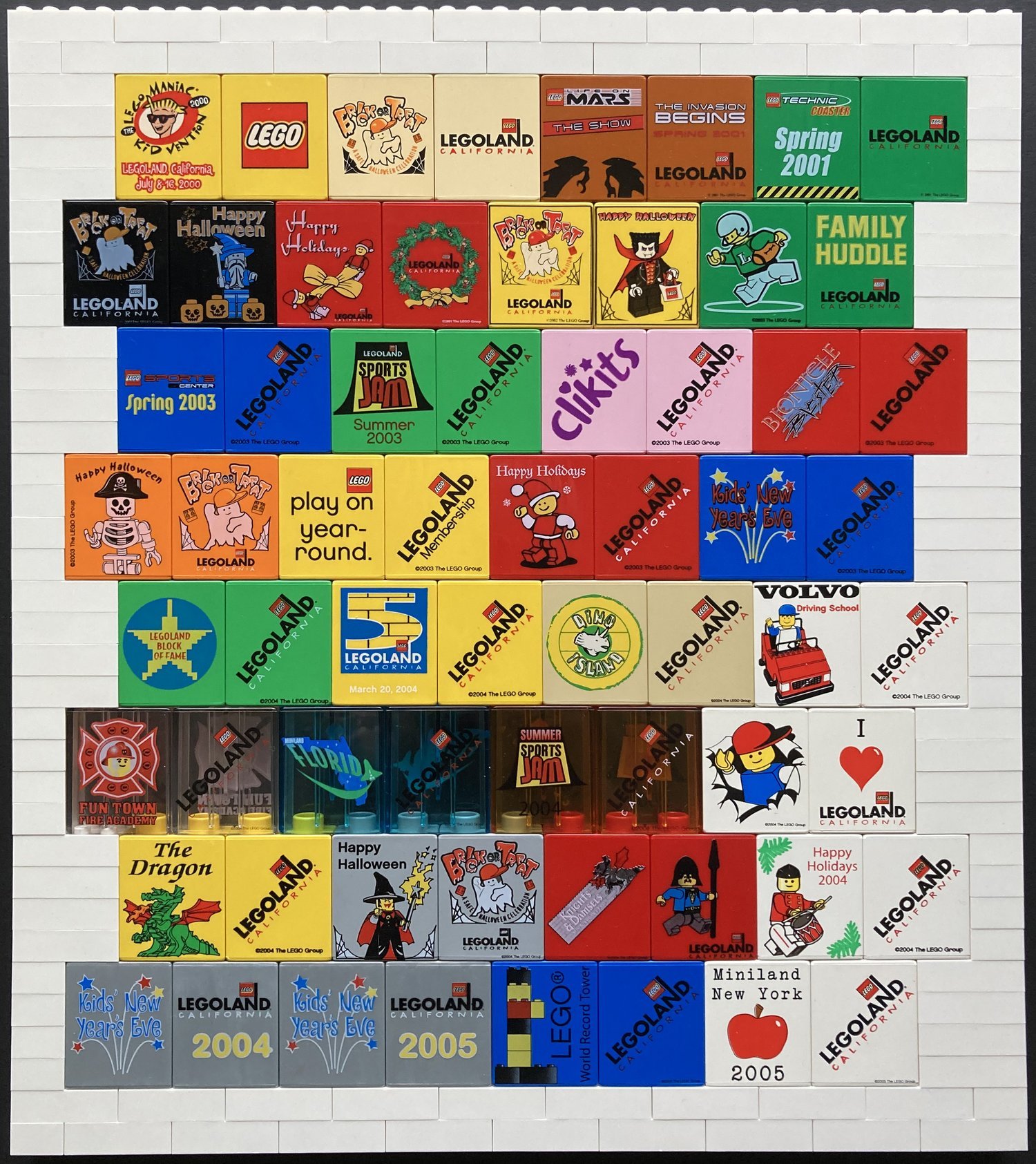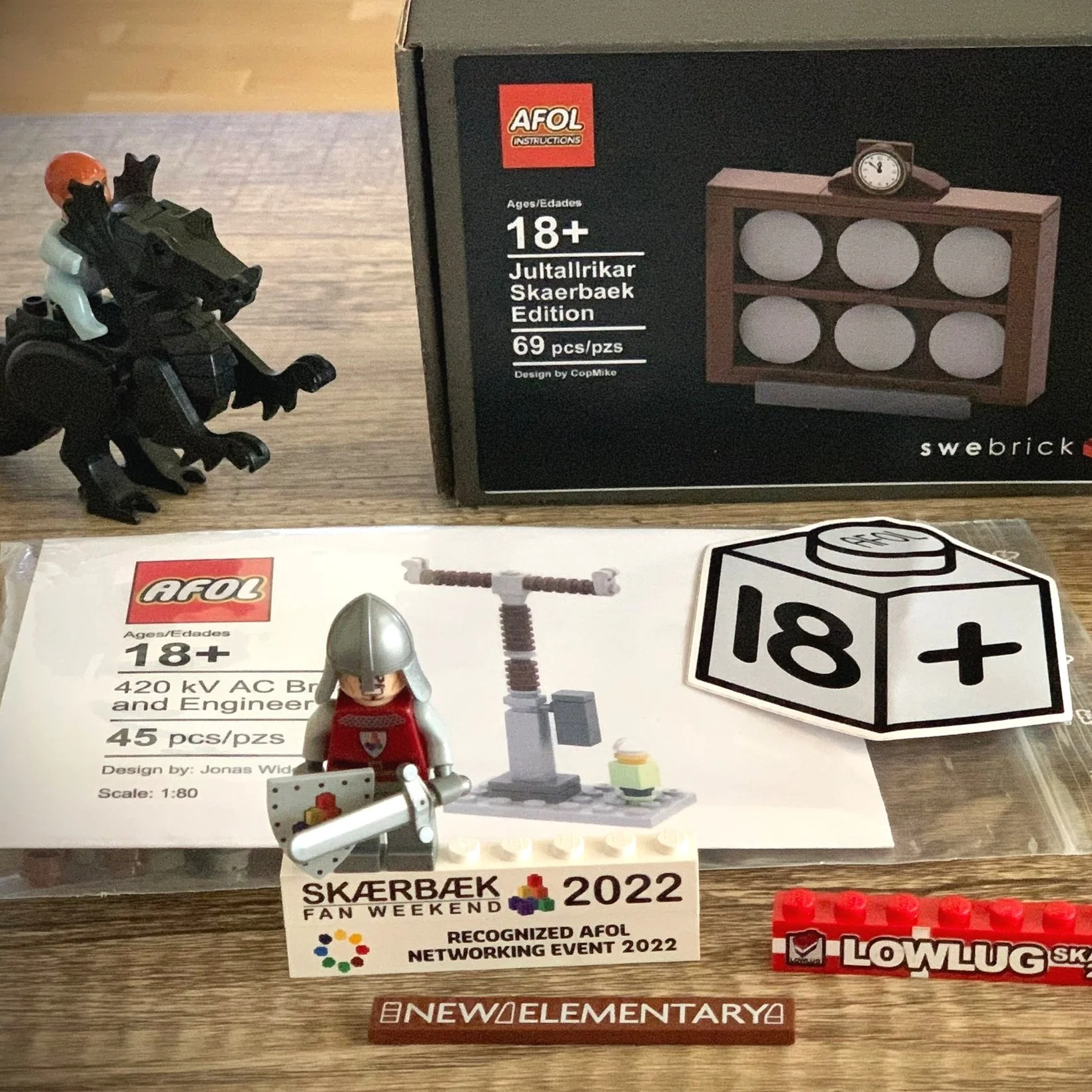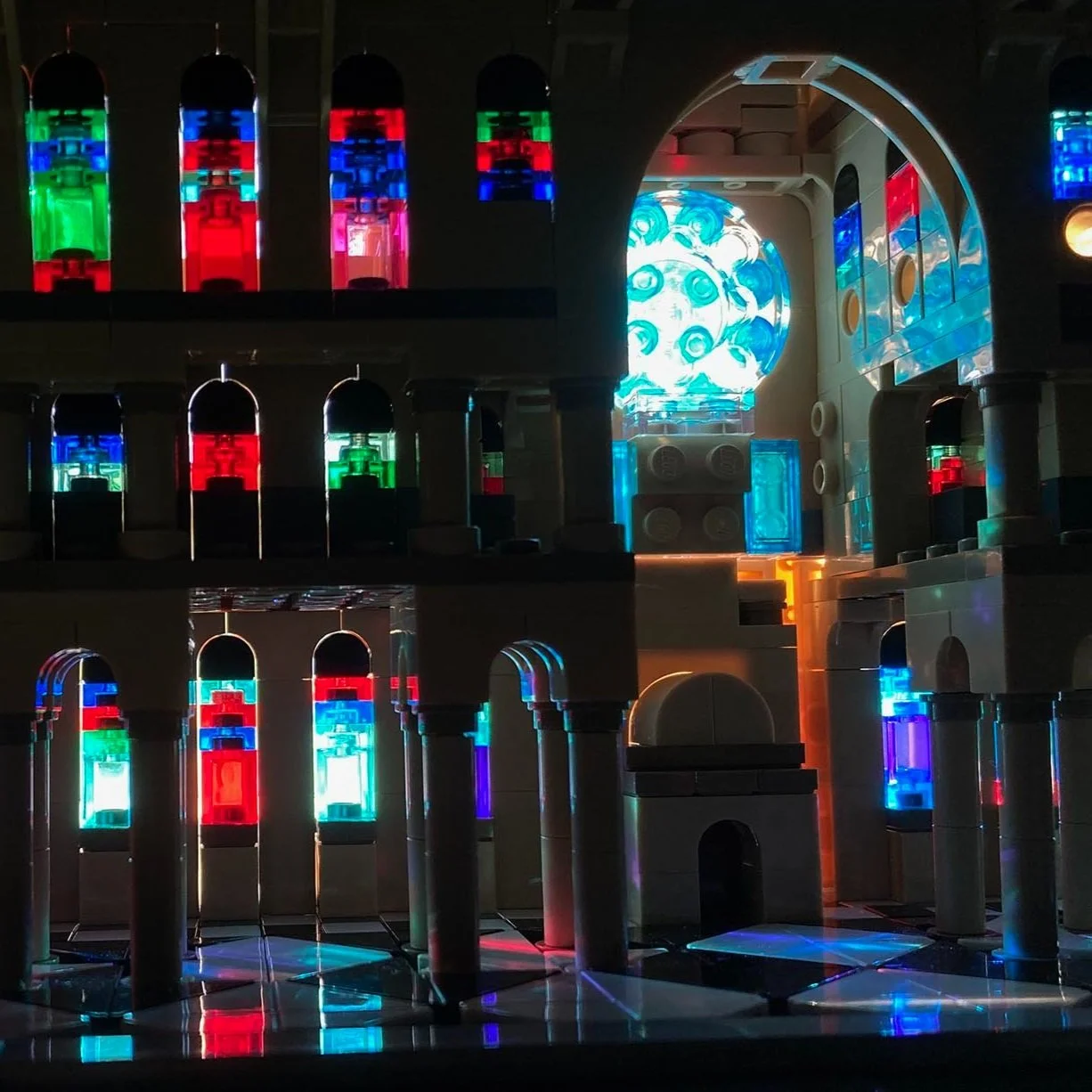Musings on Modulars: Building LEGO Modulars for the First Time
/Today’s guest article comes from Canadian AFOL Justin Speers who recently started building LEGO modulars for the first time. Justin reflects on how they changed over time, what it is like to build them in succession, how to plan out a LEGO city, and seeing where his creativity takes him.
Discovering My Passion Point
Let’s start this journey back in 2015—I had a good job and was making decent wages. I don't think I ever really fell out of love with LEGO, so my "dark age" was more a product of life demanding more attention as well as other interests capturing my time and assets (cough… Anime… cough). I was aware of the Modular Buildings line from LEGO—the Parisian Restaurant was probably the first "hey, that’s cool" stand-out set for me.
Then, I saw the Detective's Office. It wasn't a solid block of a building like previous releases but had depth and the effect of two separate buildings. Added, the whole “noir detective feel” was appealing. Now that I had money of my own and thought this was super cool, I wondered “Why not?” So I bought it, with no real plan of when to build it, or where to put it.
Image via LEGO
Over the next few years, I was able to acquire four more modular buildings, some older and some newer. By now I was fully aware of the investment value of LEGO and that sets were retired eventually—and in the case of the Modulars would become ludicrously expensive in the aftermarket. So finding a few former modular (the Parisian Restaurant and Palace Cinema) in my local LEGO Store was a lucky break and made for easy impulse buys.
Time to Spare
Fast forward to 2020. We all know what happened because of COVID, but in addition to the new social “distancing way of life,” I had also been dealt an extra bit of physical complications which just heightened my feeling of isolation. On a whim, and using a "signature minifigure" (sig-fig) of myself gifted to me a couple of years earlier, I tried my hand at minifigure photography to fill my time.
I like using the term "legography” on Instagram as Andrew Whyte's photos were a big influence for me. Family and friends seemed to get a real kick out of my creative efforts. Through this and some online happenings, namely the online BrickCon convention of 2020 and the formation of SortLug, I had finally found a supportive LEGO community.
BrickCon Online 2020 logo
Added to the experience of finding my community, I (like many other people I am sure) was watching a ridiculous amount of YouTube. Did you know there are a vast amount of people on YouTube making videos of their LEGO cities? They set them up in basements, small rooms, any space their significant others allow them to have, even just a shelf or a table in the corner. Seeing these examples and burgeoning with confidence from Zooming with my fellow AFOLs, I thought I might be able to make my own city. By now, I had made a few small MOCs and received some positive comments on my photos. But I had these five pristine modulars sitting unopened in my closest. Could I take the plunge and make a city of my own?
Building the Base (Literally)
At first, I was just in the dreaming phase. I definitely wanted to build my own city of modulars, but it was a long way off and a never concrete “this is going to happen” decision. All that really got accomplished was collecting ideas and pictures of things I wanted to do with “my city.” I made collages and drew out layout ideas because I had one big problem that needed solving, where was I going to put this city?
We have a decently sized basement where my room is located. Importantly though, I didn't need some huge sprawling layout like the ones I’d seen online. Honestly, I found myself drawn to the LEGO cities that did more with the little space they had. They seemed to be more creative in my mind. My budget was a also huge concern—I could never be one of those AFOLs that collected each and every modular to add to the city. So I wanted to focus on what I had liked from those small space builders—density over square footage.
Looking out of my bedroom at where the city could go (where I had space in my basement) for months on end, the feeling of longing (and growing boredom) finally became the catalysts for action. It took a couple of months of furniture removal and rearranging (remember the physical issues I mentioned and a pandemic!) to get the sense of order and space I needed. I’m also a night owl, so a lot of the moving had to be done very slowly and quietly so as not to disturb the day-walkers who were sleeping in the house. Additionally, there were other financial and stressful things to deal with in my life at the time—I had to go a whole year without a car of my own or income to fix this situation, so I was not in a good headspace.
New Years 2022 came, and I was still determined. Through some fortuitous turns in life, I was also now able, too. This would be good for my mental health, I told myself—a long-term project that would get me away from screens for a bit each day. After a trip to the fourth closest Home Depot (because of silly supply chain issues), I finally had the wood for my table!
I wanted to go for a modest sixty by thirty inch table (which we AFOLs know fits three baseplates deep by six baseplates long exactly). The Home Depot people were fantastic, cutting the large sheet exactly as I wanted and helping load it into my car. I saved the extra wood from the plywood sheet for future table expansion, obviously! The next issue was getting some help to move the wood into my living area. I have always strived to be a patient person, so if it took a day or two to get the help to bring the plywood indoors where I could set it up, so be it. It was still happening. I was very emotional and excited!
Construction Begins
Which modular to build first though? Deciding to have some fun, I took a picture of all of them on my newly constructed LEGO table that I was clearly very proud of. Again, all done at nighttime with my camera's timer. I slapped some numbers on the photo and had my friends and family vote. Ultimately, "build the oldest one first” won out, followed by “build them in order of oldest to newest”—that way I could see the progression of building techniques. Palace Cinema was first!
But first, MILS! One of the things I learned through YouTube and reading blogs was about this system called "MILS" or Modular Integrated Landscape System. In my mind, it looked like a sensible way to strengthen the base of the modular buildings as well as provide options for the future like lighting and landscaping. I had just enough bricks and plates in my collection to start a MILS base for the Palace Cinema, but I had to make a BrickLink order to finish the other four in this system as well. I made sure to order from as local of sellers as possible so I could keep the shipping time down and not slow down my newfound progress.
Since mid-January, I have been steadily knocking out each modular building and loving every moment of it. Generally, I build for a couple of hours each night. I have never been one to build by bag number or "knoll" (i.e. lay out all the pieces in an orderly fashion, popularized by Adam Savage of Mythbusters fame). I usually just dumped all the bags of a set into a single large bowl and dug around for the parts needed. It may sound silly and chaotic, but this process is meditative to me—time passes by as you search.
Yes, there is always that hint of panic when you can't find a particular piece and you inevitably wonder if you have been shorted by LEGO. Do I have a replacement in my meager collection? What if it's a new part or new colour? I often talk to the missing piece… “Where are you? I know you're here. Probably right in front of me." (Spoiler, invariably it is… like, seriously, I have probably been looking right at it the whole time. How did I miss that!?)
I’ve had to modify this method with the much larger sets like the modular buildings—I didn’t have a bowl big enough! But now I had a huge open table, so I now dumped all the #1 bags out, sans bowl, then hunt through all the pieces, then build, repeated for each bag number. Pro-tip: do not throw any of the bags out until the set is finished—I have had to go back through them to find a small piece here or there that had decided it didn't want to come out the first time. Then I just had to repeat that process five times for each modular.
Musings on the Modulars
Nearing completion of the modular building sets I own, I have enjoyed each build very much. I have learned so much in the way of techniques. The original decision to build in order of oldest to newest was a good one too. Going from zero tiling details inside on the Palace Cinema to the intricate tile patterns of the later buildings has been fascinating. The modulars are also a great example of building in a “forward thinking” method. For example, you're told to add certain parts in one step that make little sense, but then three or four (or even 15) steps later you have an “aha moment” seeing that confusing previous step transform into a fun detail or needed part to strengthen the build.
A couple of other things I have noted—the Palace Cinema seems to be the last modular to use stickers. Thankfully (at least in my mind), printed elements were the norm starting with the Parisian Restaurant. Not being a fan of stickers, this was a welcome change. The Detective's Office and Brick Bank seem to be the first and last sets with an integrated play feature and a clear story built into them. And starting with Assembly Square, LEGO seems to have started incorporating Easter eggs for other designers and other sets over play features. I am fine with this because nostalgia for older sets is strong among AFOLs and the play features didn't really hinder the build or its inclusion in a city where those stories won't work as easily.
One thing that will need to be addressed after the sets are complete and as my city takes shape, is that all of my five modular sets seem to be from before LEGO moved away from the classic blank smile expression of minifiugres that the modulars were once known for. All the minifigures have good torsos and accessories, but there is no variety in their faces. I will have to shop for numerous “expressive” heads as well as various skin tones to replace the yellow heads to populate my city.
While building the modulars, I have also been able to hold and use so many elements that I had only ever seen online or heard of in third-person until now. The NPU in these modulars is strong! This prompted the “minifig me” to excitedly exclaim in pictures like the one below, “I wonder what this part will be used for?”
Future Blueprints
Near the end of February, I completed all of my modulars. So what does the future hold? I have a rough plan. Remember YouTube? I also watch a lot of UK Narrowboat videos and would love to add a canal and narrowboat to my city display. Oh, and a Japanese-style market alley. Oh and… (it is never-ending project of interesting ideas!).
First up, I plan to work on some road layouts, entirely in the MILS system. This will allow me to “off-centre” the road and add only a few studs worth of sidewalk on the modulars’ side of the street where they already have some sidewalk in front of them. This is a major benefit to using the MILS system, especially when paired with LEGO’s newer road plate system. For a relatively low extra cost, you can make a road plate in any configuration you wish—you can add parallel parking spaces, intersections, curves, and even roundabouts. In earlier days, you had to purchase an entire pack of road baseplates just to get some straights ones—and then ending up with drawers full of intersection or curved-road baseplates you couldn’t use.
I also had to decide the order of the modular to display. I had planned to crowdsource various layout options again, however with two corner buildings, those naturally had to go on the ends. I lined them all up together to see which surfaces were exposed and which rooflines lined up best. The final layout kind of chose itself. In order to take advantage of the small table I built, I have also decided to eventually build in some height by raising the whole thing with some used Duplo and a Technic support structure. (You can totally utilize old and used LEGO for “filler” or support structures in my opinion!)
Looking Back
Now I am entering a phase that is more long-term and pulled from my own head. Above all though, my modular city is something I can spend time on. My budget won't allow any more big LEGO purchases these days, especially the newer Modular Buildings. But to be honest, none of them since Assembly Square have really piqued my interest the way the Detective's Office did all those years ago.
They are all wonderful creations, true, and I am intrigued by the change in the time period of the buildings' architecture in later sets, but I would rather target my LEGO purchases elsewhere at the moment. (I can use BrickLink and other sources to get what I need to make the layout I have envisioned.) I also am excited to start customizing my city more. I have a ton of bookmarks in my browser for creations from Rebrickable and similar sites for buildings, cars, and other things both large and small that I could put to good use in my city.
To end these musings on modulars, I’ll leave you with a quote that has been on my mind for a very long time—even before these modulars entered my life. Does anyone remember the movie "Ronin"? It’s got Robert DeNiro, a great car chase, and is a fun spy thriller. One scene has stuck with me since I saw it. In the movie, Michael Lonsdale's Jean-Pierre character is building a miniature diorama of "47 Ronin". He was in no hurry and just enjoyed the creation of it, clearly using the process to meditate and clear his mind. When asked the question, "When will you be done?" he replies in a way I would also reply if someone asked me the same thing about my modular city. I’d smile, shrug, and say, "Who knows. Never?"
What was your first LEGO modular experience like? Let us know in the comments below.
Do you want to help BrickNerd continue publishing articles like this one? Become a top patron like Charlie Stephens, Marc & Liz Puleo, Paige Mueller, Rob Klingberg from Brickstuff, John & Joshua Hanlon from Beyond the Brick, Megan Lum, and Andy Price to show your support, get early access, exclusive swag and more.

